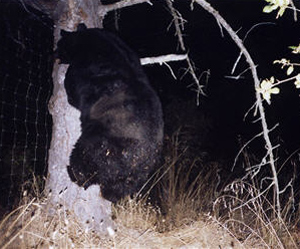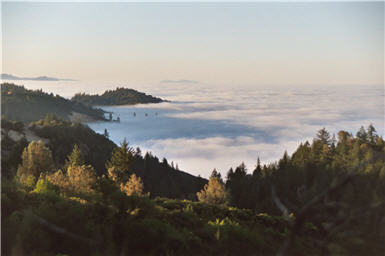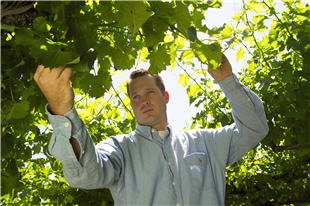

The evidence: How a vineyard high in the 'wilds' of Howell Mountain got its name.
Howell Mountain ~ Napa Valley (AVA)
Cakebread is bearish
about its newest vineyard
Literally.
by
Alan Goldfarb
December 3, 2008
 LL Dennis Cakebread wants to talk about is the bear. He walks over to a nine-foot high fence that has been rigged with electric wires and resembles the perimeter of a prison yard, and points to a wooden post that’s embedded with three-inch long gouges.
LL Dennis Cakebread wants to talk about is the bear. He walks over to a nine-foot high fence that has been rigged with electric wires and resembles the perimeter of a prison yard, and points to a wooden post that’s embedded with three-inch long gouges.
He says the bear did that when he climbed over into the vineyard. The next instant Dennis is setting up a laptop, right there on a rock outcrop that’s about 1,900 feet overlooking what seems like the entirety of the Napa Valley below.
He points to the cameras that are interspersed throughout the 200 acre site and then turns on the computer. Lo and behold, if it ain’t that black bear – all 450 pounds of him. Once again, he’s outsmarted everyone by climbing over that hot fence, deftly making sure not to brush up against an offending wire, and easing himself down into the vine rows, where he munches on Cabernet and Merlot grapes that have come to full ripeness.
“You named the vineyard after the bear,” a light bulb-inspired reporter enthuses, suddenly getting it. “It’s the Dancing Bear Ranch. Of course.”
Dancing Bear, on the much-celebrated Howell Mountain, is Cakebread Cellars’ newest vineyard for its first single-vineyard wine, and it has just given up its

Enshrouded in fog, Cakebread’s Dancing Bear Vineyard climbs from 800 to 2000 feet on Howell Mountain.
After all, the 55-year-old Cakebread is the marketing and sales manager for his family’s 175,000-case winery, which started in 1971. What else is he going to talk about? That bear, that he says got about $8,000 worth of grapes this year – and probably much more – makes for a nice story.
Oh, he’s pumped all right about the grapes that are beginning to come off the rocky soils there on hillsides that start at 800 feet and climb to almost 2,000. Just as he’s enthused about the intense black fruit with its massive tannins that are typical of Howell Mountain. The fruit is now being tamed down at the winery on the valley floor in Rutherford by winemaker Julieanne Laks – even if the bear can’t be.
Dennis is hoping that the $106 (that’s not a typo) Cab/Cab Franc blend will give Cakebread “a vineyard that we should be known for”. “We are 37 years old, but a great vineyard is what we didn’t have,” says Cakebread, invoking the name of Martha’s Vineyard, perhaps the Napa Valley’s most storied plot of ground. “Because it (DBR) has the geology, the altitude, the soil types and great views, it becomes memorable.”
Cakebread says his family bought the property in 1998 because it had lost much of its valley floor vineyards to phylloxera. DBR is the first vineyard that wasn’t contiguous to any of Cakebread’s other properties, which now consist of 885 acres, 465 of which are planted. Buying the parcel “for us, was a big deal,” he says. “We should have done it a long time ago.”
But to make Cakebread’s newest wine truly memorable – and worthy of that (odd) price – how does the vineyard’s profile, with vines that are mostly less than 10 years old, manifest in the bottle?

Cakebread’s viticulturist Toby Halkovich
I ask him the question I almost always ask winemakers and vineyard managers: Does the terroir show up in the glass? Most times they struggle with a concrete answer, and Halkovich was no exception. But with some cajoling, he gets to the essence of the query.
“Absolutely,” the terroir is in the glass, he begins, “because (the wine) is directly impacted by the growing conditions of the vine. The site is extremely limiting as to where the roots can go, and what nutrients are available. … This restricts berry size, and the size of the leaves.”
Yes, but can I taste the site in the glass?
“Everything is concentrated, and you’re going to get more tannins,” he continues, “which we had to learn to balance. The color is going to be concentrated. And there’s dark, concentrated, black fruit.”
I ask Halkovich to compare and contrast DBR with some of Cakebread’s other sites. “The fog up there (on Howell) laps up against it. It keeps it cool, and it recedes earlier than (on the valley floor),” he explains. “We get the marine influence (from the Pacific about 40 miles to the west and from San Pablo Bay, about 20 miles to the south). The peak temperatures are earlier (than in the flats and benches) and the vineyard doesn’t get the huge diurnal (from high to low) swings that we get in the lower part of the valley. The temperatures are lower than Rutherford, and there are a little more favorable conditions during harvest.”
Can DBR hold up to the single vineyard concept? In other words, is it special and unique enough to withstand such scrutiny?
“One of the wonderful things about the vineyard is that we have such a wide range of elevation and exposure,” he counters. “We have so many different growing conditions that it lends itself to blending. It’s not like a flat vineyard where you get homogenized soils and only ‘one’ wine. Its uniqueness is the diversity of the site, plus it’s got one of the best views in the valley.”
Which brings us back to Dennis Cakebread and that confounding varmint, the dancing, grape-marauding bear. Despite all the technology – cameras, electrified fences, and computers - the animal always seems to get his way.
Which leads Cakebread to conclude, almost willingly, “what we’re wondering is will we ever be smarter than the bear?”
That said, the damage may just be offset - one hundred and six dollars later -by
 what could prove to be, in time, a bullish bear of a wine. Chalk the collateral bear damage up to the cost of doing business, and what the Cakebreads might have in the end, is something smarter than any bear. We’ll bare that in mind.
what could prove to be, in time, a bullish bear of a wine. Chalk the collateral bear damage up to the cost of doing business, and what the Cakebreads might have in the end, is something smarter than any bear. We’ll bare that in mind.
Photos courtesy of Dennis Cakebread and Cakebread Winery










 READER FEEDBACK: To post your comments on this story,
READER FEEDBACK: To post your comments on this story,




